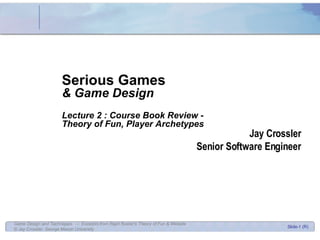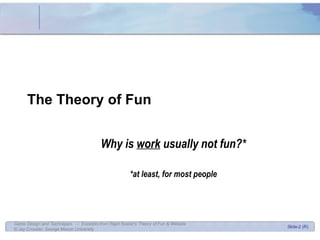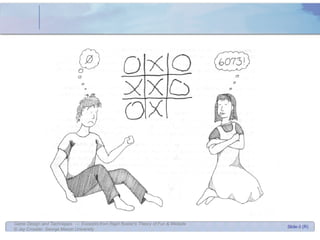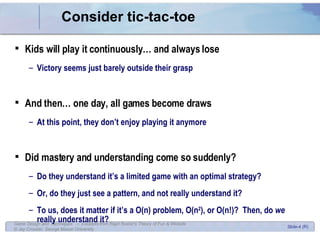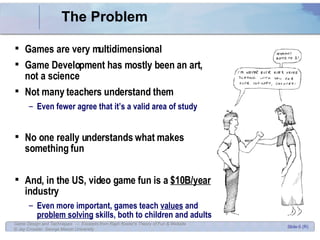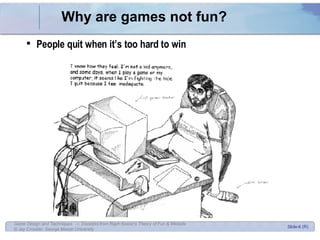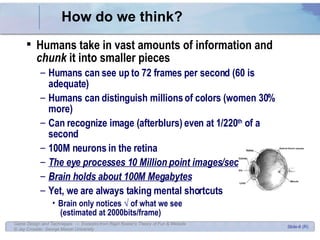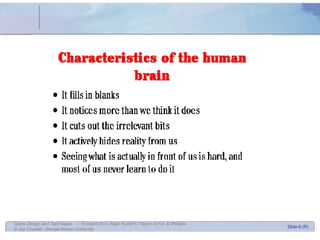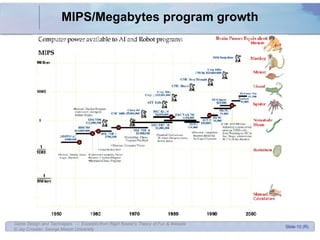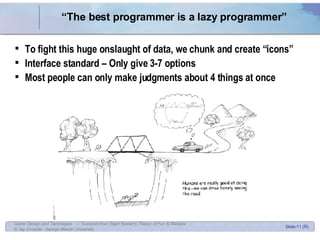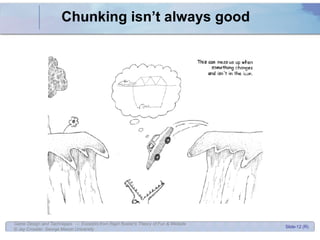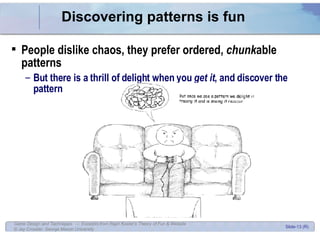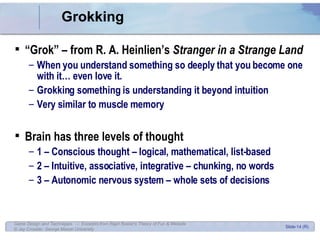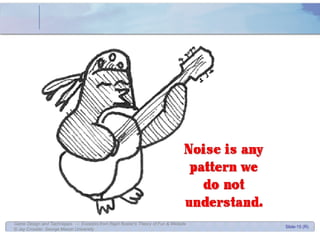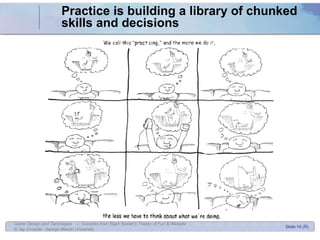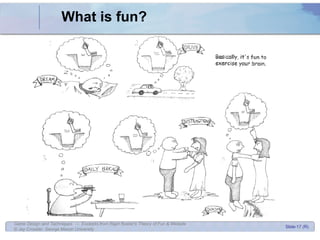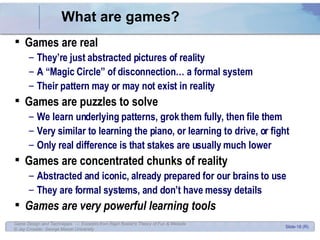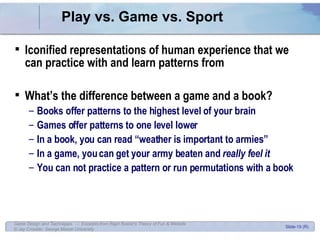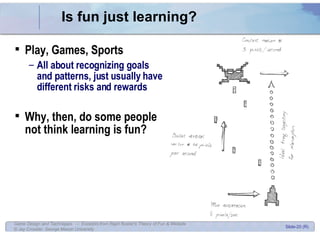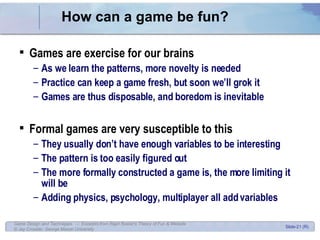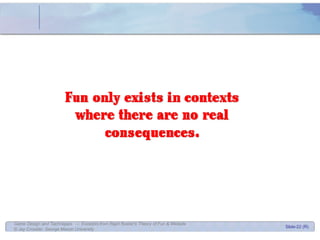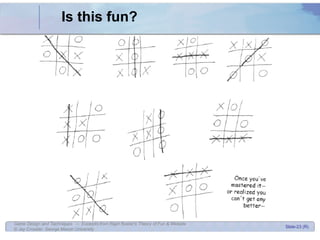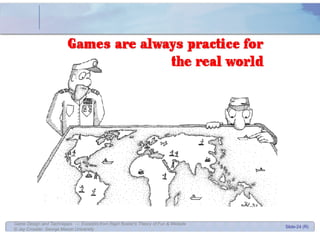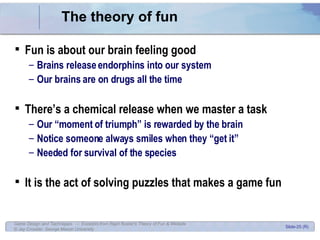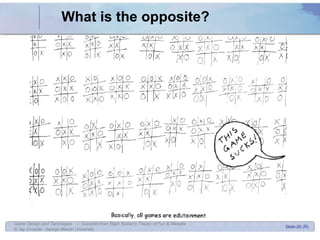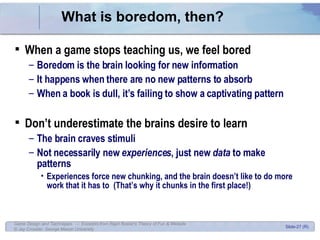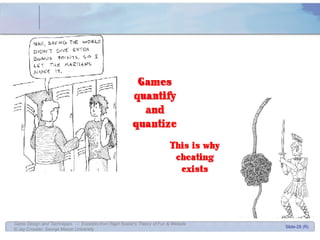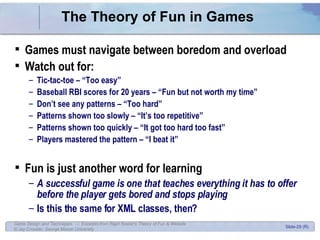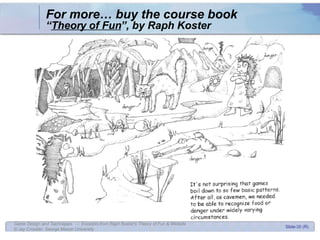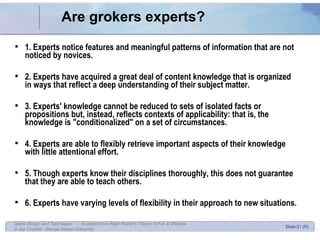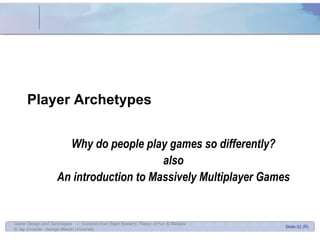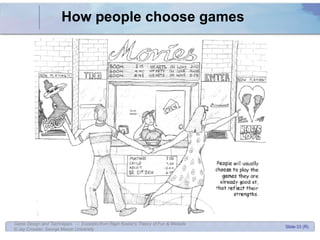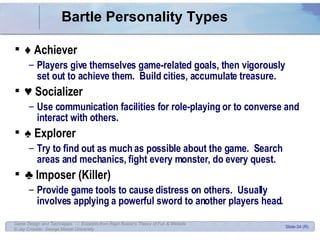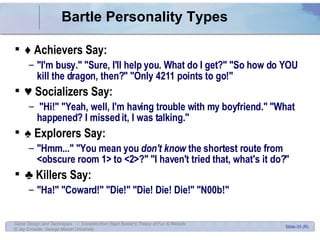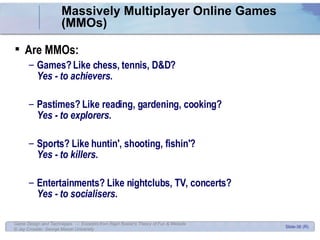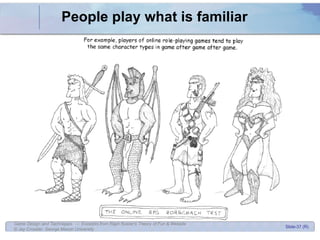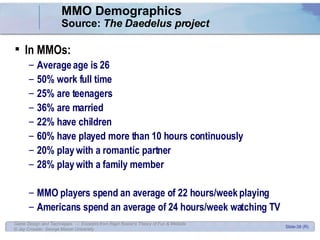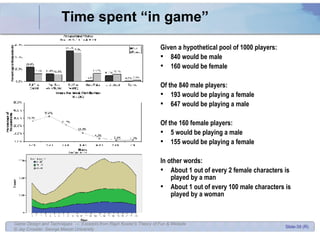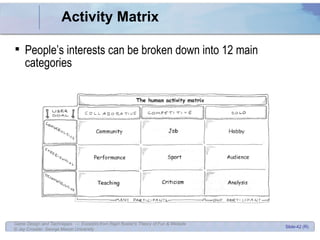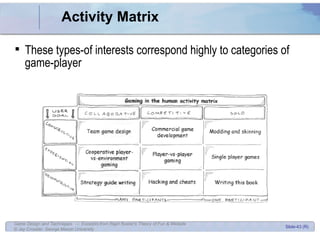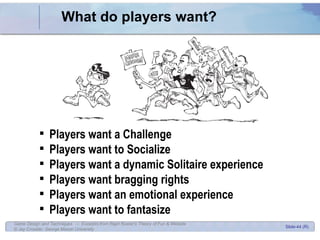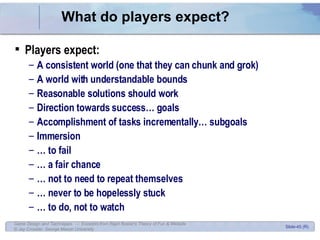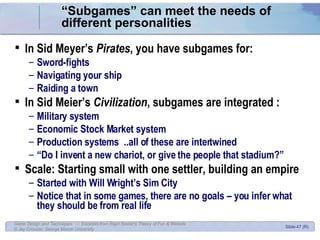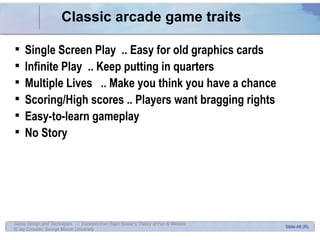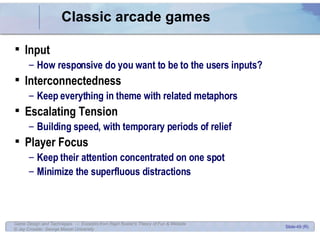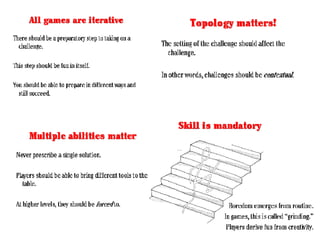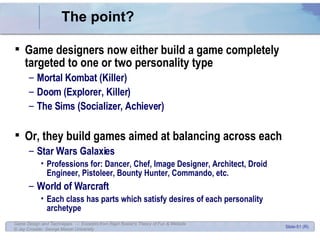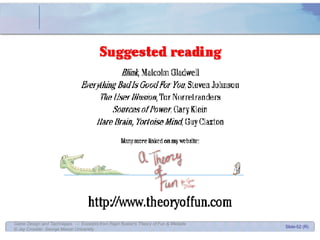Theory Of Fun
- 1. Jay Crossler Senior Software Engineer Serious Games & Game Design Lecture 2 : Course Book Review - Theory of Fun, Player Archetypes
- 2. The Theory of Fun Why is work usually not fun?* *at least, for most people
- 3. Ėý
- 4. Consider tic-tac-toe Kids will play it continuouslyâĶ and always lose Victory seems just barely outside their grasp And thenâĶ one day, all games become draws At this point, they donât enjoy playing it anymore Did mastery and understanding come so suddenly? Do they understand itâs a limited game with an optimal strategy? Or, do they just see a pattern, and not really understand it? To us, does it matter if itâs a O(n) problem, O(n 2 ), or O(n!)? Then, do we really understand it?
- 5. The Problem Games are very multidimensional Game Development has mostly been an art, not a science Not many teachers understand them Even fewer agree that itâs a valid area of study No one really understands what makes something fun And, in the US, video game fun is a $10B/year industry Even more important, games teach values and problem solving skills, both to children and adults
- 6. Why are games not fun? People quit when itâs too hard to win
- 7. Why are games not fun? People quit when itâs too easy to win
- 8. How do we think? Humans take in vast amounts of information and chunk it into smaller pieces Humans can see up to 72 frames per second (60 is adequate) Humans can distinguish millions of colors (women 30% more) Can recognize image (afterblurs) even at 1/220 th of a second 100M neurons in the retina The eye processes 10 Million point images/sec Brain holds about 100M Megabytes Yet, we are always taking mental shortcuts Brain only notices â of what we see (estimated at 2000bits/frame)
- 9. Ėý
- 11. â The best programmer is a lazy programmerâ To fight this huge onslaught of data, we chunk and create âiconsâ Interface standard â Only give 3-7 options Most people can only make judgments about 4 things at once
- 12. Chunking isnât always good
- 13. Discovering patterns is fun People dislike chaos, they prefer ordered, chunk able patterns But there is a thrill of delight when you get it , and discover the pattern
- 14. Grokking â Grokâ â from R. A. Heinlienâs Stranger in a Strange Land When you understand something so deeply that you become one with itâĶ even love it. Grokking something is understanding it beyond intuition Very similar to muscle memory Brain has three levels of thought 1 â Conscious thought â logical, mathematical, list-based 2 â Intuitive, associative, integrative â chunking, no words 3 â Autonomic nervous system â whole sets of decisions
- 15. Ėý
- 16. Practice is building a library of chunked skills and decisions
- 17. What is fun?
- 18. What are games? Games are real Theyâre just abstracted pictures of reality A âMagic Circleâ of disconnectionâĶ a formal system Their pattern may or may not exist in reality Games are puzzles to solve We learn underlying patterns, grok them fully, then file them Very similar to learning the piano, or learning to drive, or fight Only real difference is that stakes are usually much lower Games are concentrated chunks of reality Abstracted and iconic, already prepared for our brains to use They are formal systems, and donât have messy details Games are very powerful learning tools
- 19. Play vs. Game vs. Sport Iconified representations of human experience that we can practice with and learn patterns from Whatâs the difference between a game and a book? Books offer patterns to the highest level of your brain Games offer patterns to one level lower In a book, you can read âweather is important to armiesâ In a game, you can get your army beaten and really feel it You can not practice a pattern or run permutations with a book
- 20. Is fun just learning? Play, Games, Sports All about recognizing goals and patterns, just usually have different risks and rewards Why, then, do some people not think learning is fun?
- 21. How can a game be fun? Games are exercise for our brains As we learn the patterns, more novelty is needed Practice can keep a game fresh, but soon weâll grok it Games are thus disposable, and boredom is inevitable Formal games are very susceptible to this They usually donât have enough variables to be interesting The pattern is too easily figured out The more formally constructed a game is, the more limiting it will be Adding physics, psychology, multiplayer all add variables
- 22. Ėý
- 23. Is this fun?
- 24. Ėý
- 25. The theory of fun Fun is about our brain feeling good Brains release endorphins into our system Our brains are on drugs all the time Thereâs a chemical release when we master a task Our âmoment of triumphâ is rewarded by the brain Notice someone always smiles when they âget itâ Needed for survival of the species It is the act of solving puzzles that makes a game fun
- 26. What is the opposite?
- 27. What is boredom, then? When a game stops teaching us, we feel bored Boredom is the brain looking for new information It happens when there are no new patterns to absorb When a book is dull, itâs failing to show a captivating pattern Donât underestimate the brains desire to learn The brain craves stimuli Not necessarily new experiences , just new data to make patterns Experiences force new chunking, and the brain doesnât like to do more work that it has to (Thatâs why it chunks in the first place!)
- 28. Ėý
- 29. The Theory of Fun in Games Games must navigate between boredom and overload Watch out for: Tic-tac-toe â âToo easyâ Baseball RBI scores for 20 years â âFun but not worth my timeâ Donât see any patterns â âToo hardâ Patterns shown too slowly â âItâs too repetitiveâ Patterns shown too quickly â âIt got too hard too fastâ Players mastered the pattern â âI beat itâ Fun is just another word for learning A successful game is one that teaches everything it has to offer before the player gets bored and stops playing Is this the same for XML classes, then?
- 30. For moreâĶ buy the course book â Theory of Fun â, by Raph Koster
- 31. Are grokers experts? 1. Experts notice features and meaningful patterns of information that are not noticed by novices. 2. Experts have acquired a great deal of content knowledge that is organized in ways that reflect a deep understanding of their subject matter. 3. Experts' knowledge cannot be reduced to sets of isolated facts or propositions but, instead, reflects contexts of applicability: that is, the knowledge is "conditionalized" on a set of circumstances. 4. Experts are able to flexibly retrieve important aspects of their knowledge with little attentional effort. 5. Though experts know their disciplines thoroughly, this does not guarantee that they are able to teach others. 6. Experts have varying levels of flexibility in their approach to new situations.
- 32. Player Archetypes Why do people play games so differently? also An introduction to Massively Multiplayer Games
- 33. How people choose games
- 34. Bartle Personality Types âĶ Achiever Players give themselves game-related goals, then vigorously set out to achieve them. Build cities, accumulate treasure. âĨ Socializer Use communication facilities for role-playing or to converse and interact with others. â Explorer Try to find out as much as possible about the game. Search areas and mechanics, fight every monster, do every quest. âĢ Imposer (Killer) Provide game tools to cause distress on others. Usually involves applying a powerful sword to another players head.
- 35. Bartle Personality Types âĶ Achievers Say: "I'm busy." "Sure, I'll help you. What do I get?" "So how do YOU kill the dragon, then?" "Only 4211 points to go!" âĨ Socializers Say: "Hi!" "Yeah, well, I'm having trouble with my boyfriend." "What happened? I missed it, I was talking." â Explorers Say: "Hmm..." "You mean you don't know the shortest route from <obscure room 1> to <2>?" "I haven't tried that, what's it do?" âĢ Killers Say: "Ha!" "Coward!" "Die!" "Die! Die! Die!" "N00b!"
- 36. Massively Multiplayer Online Games (MMOs) Are MMOs: Games? Like chess, tennis, D&D? Yes - to achievers. Pastimes? Like reading, gardening, cooking? Yes - to explorers. Sports? Like huntin', shooting, fishin'? Yes - to killers. Entertainments? Like nightclubs, TV, concerts? Yes - to socialisers.
- 37. People play what is familiar
- 38. MMO Demographics Source: The Daedelus project In MMOs: Average age is 26 50% work full time 25% are teenagers 36% are married 22% have children 60% have played more than 10 hours continuously 20% play with a romantic partner 28% play with a family member MMO players spend an average of 22 hours/week playing Americans spend an average of 24 hours/week watching TV
- 39. Time spent âin gameâ Given a hypothetical pool of 1000 players: 840 would be male 160 would be female Of the 840 male players: 193 would be playing a female 647 would be playing a male Of the 160 female players: 5 would be playing a male 155 would be playing a female In other words: About 1 out of every 2 female characters is played by a man About 1 out of every 100 male characters is played by a woman
- 41. Profession Types, Life Lessons
- 42. Activity Matrix Peopleâs interests can be broken down into 12 main categories
- 43. Activity Matrix These types-of interests correspond highly to categories of game-player
- 44. What do players want? Players want a Challenge Players want to Socialize Players want a dynamic Solitaire experience Players want bragging rights Players want an emotional experience Players want to fantasize
- 45. What do players expect? Players expect: A consistent world (one that they can chunk and grok) A world with understandable bounds Reasonable solutions should work Direction towards successâĶ goals Accomplishment of tasks incrementallyâĶ subgoals Immersion âĶ to fail âĶ a fair chance âĶ not to need to repeat themselves âĶ never to be hopelessly stuck âĶ to do, not to watch
- 46. How do you satisfy people? Use Interface conventions Let them rely on their existing knowledge A familiar topic helps people get right into the game Give a lot of positive feedback early in the game Give them the idea theyâre on the right track Everything they do, the computer acknowledges it, recognizes it, and thinks itâs really cool Prototype! In 2 years of development, 1.25 of it is for playing/testing Balance so that itâs not boring/too hard is crucial
- 47. â Subgamesâ can meet the needs of different personalities In Sid Meyerâs Pirates , you have subgames for: Sword-fights Navigating your ship Raiding a town In Sid Meierâs Civilization , subgames are integrated : Military system Economic Stock Market system Production systems ..all of these are intertwined â Do I invent a new chariot, or give the people that stadium?â Scale: Starting small with one settler, building an empire Started with Will Wrightâs Sim City Notice that in some games, there are no goals â you infer what they should be from real life
- 48. Classic arcade game traits Single Screen Play .. Easy for old graphics cards Infinite Play .. Keep putting in quarters Multiple Lives .. Make you think you have a chance Scoring/High scores .. Players want bragging rights Easy-to-learn gameplay No Story
- 49. Classic arcade games Input How responsive do you want to be to the users inputs? Interconnectedness Keep everything in theme with related metaphors Escalating Tension Building speed, with temporary periods of relief Player Focus Keep their attention concentrated on one spot Minimize the superfluous distractions
- 50. Ėý
- 51. The point? Game designers now either build a game completely targeted to one or two personality type Mortal Kombat (Killer) Doom (Explorer, Killer) The Sims (Socializer, Achiever) Or, they build games aimed at balancing across each Star Wars Galaxies Professions for: Dancer, Chef, Image Designer, Architect, Droid Engineer, Pistoleer, Bounty Hunter, Commando, etc. World of Warcraft Each class has parts which satisfy desires of each personality archetype
- 52. Ėý

